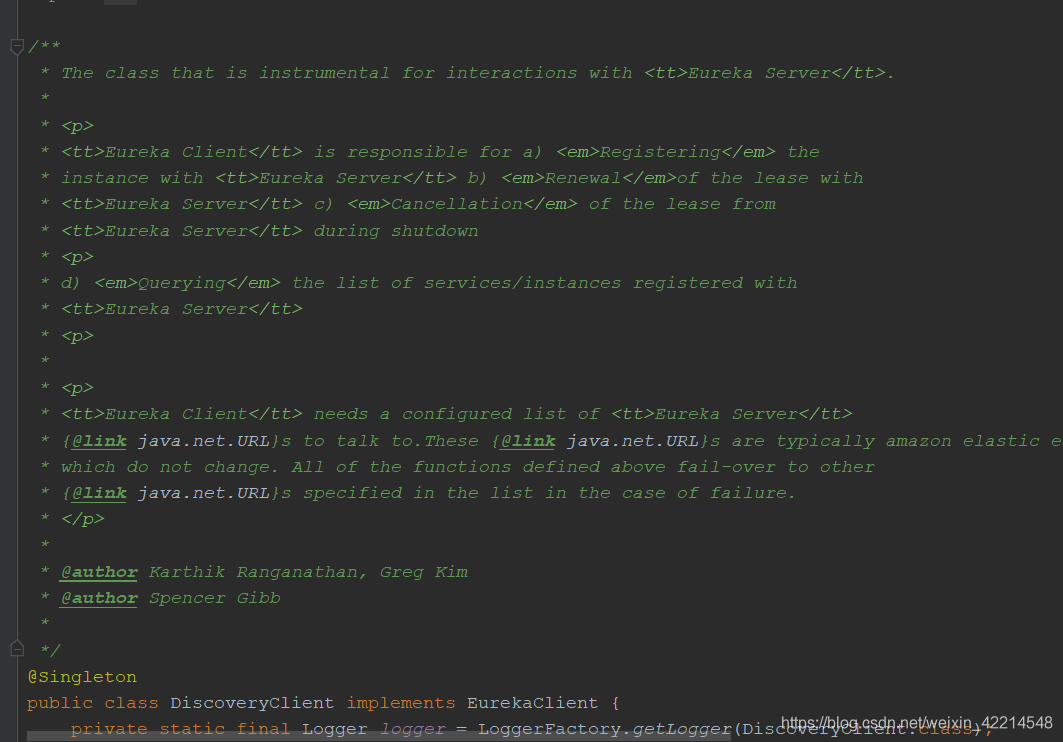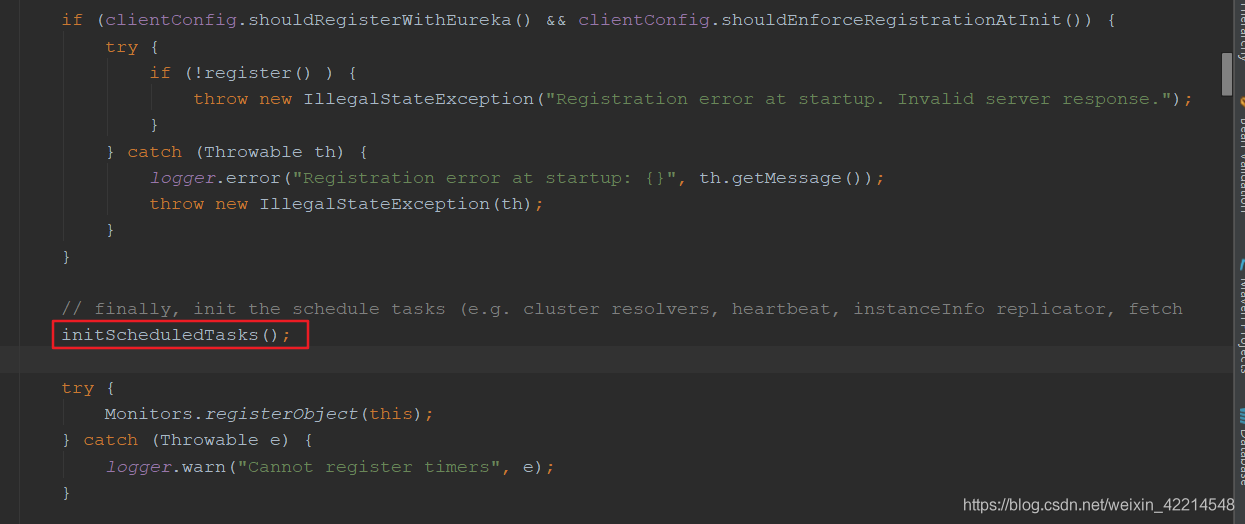前言
Eureka可分为客户端和服务端两个部分,本篇主要介绍的客户端的运行机制和概念.
Eureka客户端主要实现的功能分别是服务注册,服务发现,服务续约
服务注册:Eureka Client会通过发送REST请求的方式向Eureka Server注册自己的服务,提供自身的元数据,比如ip地址、端口、运行状况指标的url、主页地址等信息。Eureka Server接收到注册请求后,就会把这些元数据信息存储在一个双层的Map中。
服务续约:在服务注册后,Eureka Client会维护一个心跳来持续通知Eureka Server,默认每30秒发送一次
获取服务:服务消费者(Eureka Client)在启动的时候,会发送一个REST请求给Eureka Server,获取上面注册的服务清单,并且缓存在Eureka Client本地,默认缓存30秒。
源码阅读
Eureka客户端的实现主要依靠注解@EnableDiscoveryClient开始,所以我们先看看注解中有什么信息

我们在注解类中可以看到一段注释信息,告诉我们这个注解的作用主要是为了启动DiscoveryClient实现.这个提示还是比较明显哦,我们进入DiscoveryClient看看

类上面的注释,说明了这个类是用来帮助和Eureka Server互相协作的,可以进行服务注册,服务续约,服务下线,获取服务列表.
没错,这个就是Eureka 客户端的核心实现类,在DiscoveryClient类中可以看到有很多方法,包括register()、renew()、shutdown()、unregister()等。
既然Eureka Client需要一开始先初始化DiscoveryClient实例,那就看下DiscoveryClient的构造方法。在其中的一个构造方法中可以看到他调用了initScheduledTasks();

我们跟进这个方法看个究竟
/**
* Initializes all scheduled tasks.
*/
private void initScheduledTasks() {
if (clientConfig.shouldFetchRegistry()) {
// registry cache refresh timer
int registryFetchIntervalSeconds = clientConfig.getRegistryFetchIntervalSeconds();
int expBackOffBound = clientConfig.getCacheRefreshExecutorExponentialBackOffBound();
cacheRefreshTask = new TimedSupervisorTask(
"cacheRefresh",
scheduler,
cacheRefreshExecutor,
registryFetchIntervalSeconds,
TimeUnit.SECONDS,
expBackOffBound,
new CacheRefreshThread()
);
scheduler.schedule(
cacheRefreshTask,
registryFetchIntervalSeconds, TimeUnit.SECONDS);
}
if (clientConfig.shouldRegisterWithEureka()) {
int renewalIntervalInSecs = instanceInfo.getLeaseInfo().getRenewalIntervalInSecs();
int expBackOffBound = clientConfig.getHeartbeatExecutorExponentialBackOffBound();
logger.info("Starting heartbeat executor: " + "renew interval is: {}", renewalIntervalInSecs);
// Heartbeat timer
heartbeatTask = new TimedSupervisorTask(
"heartbeat",
scheduler,
heartbeatExecutor,
renewalIntervalInSecs,
TimeUnit.SECONDS,
expBackOffBound,
new HeartbeatThread()
);
scheduler.schedule(
heartbeatTask,
renewalIntervalInSecs, TimeUnit.SECONDS);
// InstanceInfo replicator
instanceInfoReplicator = new InstanceInfoReplicator(
this,
instanceInfo,
clientConfig.getInstanceInfoReplicationIntervalSeconds(),
2); // burstSize
statusChangeListener = new ApplicationInfoManager.StatusChangeListener() {
@Override
public String getId() {
return "statusChangeListener";
}
@Override
public void notify(StatusChangeEvent statusChangeEvent) {
if (InstanceStatus.DOWN == statusChangeEvent.getStatus() ||
InstanceStatus.DOWN == statusChangeEvent.getPreviousStatus()) {
// log at warn level if DOWN was involved
logger.warn("Saw local status change event {}", statusChangeEvent);
} else {
logger.info("Saw local status change event {}", statusChangeEvent);
}
instanceInfoReplicator.onDemandUpdate();
}
};
if (clientConfig.shouldOnDemandUpdateStatusChange()) {
applicationInfoManager.registerStatusChangeListener(statusChangeListener);
}
instanceInfoReplicator.start(clientConfig.getInitialInstanceInfoReplicationIntervalSeconds());
} else {
logger.info("Not registering with Eureka server per configuration");
}
}该方法通过多个if判断实现,第一个if判断if (clientConfig.shouldFetchRegistry())是判断是否需要拉去eureka服务端的注册列表,如果需要则会开始定时调度线程,每隔30秒拉去一次.
第二个if判断 if (clientConfig.shouldRegisterWithEureka())是判断是否需要将自己注册到eureka服务端中,如果为true则开启一个服务续约的定时调度线程,每隔30秒续约一次
并且new了一个InstanceInfoReplicator类,该类很重要,他实现了Runable接口,在它的run方法中会发起服务注册.
public void run() {
try {
discoveryClient.refreshInstanceInfo();
Long dirtyTimestamp = instanceInfo.isDirtyWithTime();
if (dirtyTimestamp != null) {
discoveryClient.register();
instanceInfo.unsetIsDirty(dirtyTimestamp);
}
} catch (Throwable t) {
logger.warn("There was a problem with the instance info replicator", t);
} finally {
Future next = scheduler.schedule(this, replicationIntervalSeconds, TimeUnit.SECONDS);
scheduledPeriodicRef.set(next);
}
}discoveryClient.register();调用真正的注册方法,对当前的节点进行服务注册
/**
* Register with the eureka service by making the appropriate REST call.
*/
boolean register() throws Throwable {
logger.info(PREFIX + "{}: registering service...", appPathIdentifier);
EurekaHttpResponse<Void> httpResponse;
try {
httpResponse = eurekaTransport.registrationClient.register(instanceInfo);
} catch (Exception e) {
logger.warn(PREFIX + "{} - registration failed {}", appPathIdentifier, e.getMessage(), e);
throw e;
}
if (logger.isInfoEnabled()) {
logger.info(PREFIX + "{} - registration status: {}", appPathIdentifier, httpResponse.getStatusCode());
}
return httpResponse.getStatusCode() == Status.NO_CONTENT.getStatusCode();
}
httpResponse = eurekaTransport.registrationClient.register(instanceInfo);通过这段代码最后返回响应信息,完成整个客户端的服务注册